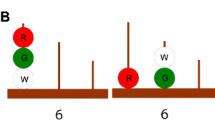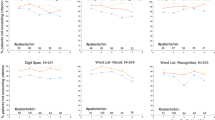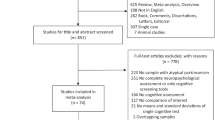Abstract
Objective
Timed neuropsychological tests do not take into account physical impairment during scoring procedures. Dysarthria and upper limb impairment can be easily measured with the PATA rate test (PRT) and the nine-hole pegboard test (9HPT). We recently validated a normalization method for timed neuropsychological tests using the PRT and 9HPT (p9NORM). We now validate the p9NORM in Parkinson’s disease (Yarnall et al. Neurology 82(4):308–316; 2014) and multiple system atrophy (MSA).
Methods
We enrolled twenty-six patients with PD, eighteen patients with MSA, and fifteen healthy controls (HC). p9NORM was applied to patients with abnormal PRT and/or 9HPT. All subjects were tested with a comprehensive neuropsychological battery.
Results
No differences emerged in demographics across groups: (PD: mean age ± SD 66 ± 8; education 9 ± 4 years; MSA: age 60 ± 8; education 10 ± 4 years; HC: age 61 ± 12; education 9 ± 4 years). In MSA patients, the scores on the trail making test (TMT-A p = 0.003; TMT-B p = 0.018), attentional matrices (AM; p = 0.042), and symbol digit modalities test (SDMT p = 0.027) significantly differed following application of p9NORM. In PD patients, the TMT-A (p < 0.001), TMT-B (p = 0.001), and AM (p = 0.001) differed after correction. PD and MSA showed cognitive impairment relative to HC performance. When comparing MSA with PD, the SDMT, AM, and fluencies were similar. TMT-A and -B raw scores were different between groups (p = 0.006; p = 0.034), but these differences lost significance after p9NORM corrections (p = 0.100; p = 0.186).
Conclusions
We confirm that the p9NORM can be successfully used in both PD and MSA patients, as it mitigates the impact of disability on timed tests, resulting in a more accurate analysis of cognitive domains.


Similar content being viewed by others
Data availability
The datasets generated and analyzed during the current study are available from the corresponding author on reasonable request.
References
Sacca F, Costabile T, Abate F, Liguori A, Paciello F, Pane C, De Rosa A, Manganelli F, De Michele G, Filla A (2018) Normalization of timed neuropsychological tests with the PATA rate and nine-hole pegboard tests. J Neuropsychol 12(3):471–483. https://doi.org/10.1111/jnp.12125
Schmitz-Hubsch T, Giunti P, Stephenson DA, Globas C, Baliko L, Sacca F, Mariotti C, Rakowicz M, Szymanski S, Infante J, van de Warrenburg BP, Timmann D, Fancellu R, Rola R, Depondt C, Schols L, Zdzienicka E, Kang JS, Dohlinger S, Kremer B, Melegh B, Filla A, Klockgether T (2008) SCA Functional Index: a useful compound performance measure for spinocerebellar ataxia. Neurology 71(7):486–492. https://doi.org/10.1212/01.wnl.0000324863.76290.19
Oxford Grice K, Vogel KA, Le V, Mitchell A, Muniz S, Vollmer MA (2003) Adult norms for a commercially available Nine Hole Peg Test for finger dexterity. Am J Occup Ther 57(5):570–573. https://doi.org/10.5014/ajot.57.5.570
Yarnall AJ, Breen DP, Duncan GW, Khoo TK, Coleman SY, Firbank MJ, Nombela C, Winder-Rhodes S, Evans JR, Rowe JB, Mollenhauer B, Kruse N, Hudson G, Chinnery PF, O’Brien JT, Robbins TW, Wesnes K, Brooks DJ, Barker RA, Burn DJ, Group I-PS (2014) Characterizing mild cognitive impairment in incident Parkinson disease: the ICICLE-PD study. Neurology 82(4):308–316. https://doi.org/10.1212/WNL.0000000000000066
Zis P, Rizos A, Martinez-Martin P, Pal S, Silverdale M, Sharma JC, Sauerbier A, Chaudhuri KR (2014) Non-motor symptoms profile and burden in drug naive versus long-term Parkinson’s disease patients. J Park Dis 4(3):541–547. https://doi.org/10.3233/JPD-140372
Litvan I, Goldman JG, Troster AI, Schmand BA, Weintraub D, Petersen RC, Mollenhauer B, Adler CH, Marder K, Williams-Gray CH, Aarsland D, Kulisevsky J, Rodriguez-Oroz MC, Burn DJ, Barker RA, Emre M (2012) Diagnostic criteria for mild cognitive impairment in Parkinson’s disease: Movement Disorder Society Task Force guidelines. Mov Disord 27(3):349–356. https://doi.org/10.1002/mds.24893
Aarsland D, Bronnick K, Williams-Gray C, Weintraub D, Marder K, Kulisevsky J, Burn D, Barone P, Pagonabarraga J, Allcock L, Santangelo G, Foltynie T, Janvin C, Larsen JP, Barker RA, Emre M (2010) Mild cognitive impairment in Parkinson disease: a multicenter pooled analysis. Neurology 75(12):1062–1069. https://doi.org/10.1212/WNL.0b013e3181f39d0e
Kehagia AA, Barker RA, Robbins TW (2010) Neuropsychological and clinical heterogeneity of cognitive impairment and dementia in patients with Parkinson’s disease. Lancet Neurol 9(12):1200–1213. https://doi.org/10.1016/S1474-4422(10)70212-X
Mattay VS, Tessitore A, Callicott JH, Bertolino A, Goldberg TE, Chase TN, Hyde TM, Weinberger DR (2002) Dopaminergic modulation of cortical function in patients with Parkinson’s disease. Ann Neurol 51(2):156–164. https://doi.org/10.1002/ana.10078
Rakshi JS, Uema T, Ito K, Bailey DL, Morrish PK, Ashburner J, Dagher A, Jenkins IH, Friston KJ, Brooks DJ (1999) Frontal, midbrain and striatal dopaminergic function in early and advanced Parkinson’s disease A 3D [(18)F]dopa-PET study. Brain 122(Pt 9):1637–1650. https://doi.org/10.1093/brain/122.9.1637
Kehagia AA, Barker RA, Robbins TW (2013) Cognitive impairment in Parkinson’s disease: the dual syndrome hypothesis. Neurodegener Dis 11(2):79–92. https://doi.org/10.1159/000341998
Pagonabarraga J, Kulisevsky J (2012) Cognitive impairment and dementia in Parkinson’s disease. Neurobiol Dis 46(3):590–596. https://doi.org/10.1016/j.nbd.2012.03.029
Wenning GK, Tison F, Ben Shlomo Y, Daniel SE, Quinn NP (1997) Multiple system atrophy: a review of 203 pathologically proven cases. Mov Disord 12(2):133–147. https://doi.org/10.1002/mds.870120203
Gilman S, Wenning GK, Low PA, Brooks DJ, Mathias CJ, Trojanowski JQ, Wood NW, Colosimo C, Durr A, Fowler CJ, Kaufmann H, Klockgether T, Lees A, Poewe W, Quinn N, Revesz T, Robertson D, Sandroni P, Seppi K, Vidailhet M (2008) Second consensus statement on the diagnosis of multiple system atrophy. Neurology 71(9):670–676. https://doi.org/10.1212/01.wnl.0000324625.00404.15
Kawamura K, Shimohata T, Nakayama H, Tomita M, Ozawa T, Nishizawa M (2010) Factors influencing the cognitive function in patients with multiple system atrophy. Mov Disord 25(16):2891–2892. https://doi.org/10.1002/mds.23260
O’Sullivan SS, Massey LA, Williams DR, Silveira-Moriyama L, Kempster PA, Holton JL, Revesz T, Lees AJ (2008) Clinical outcomes of progressive supranuclear palsy and multiple system atrophy. Brain 131(Pt 5):1362–1372. https://doi.org/10.1093/brain/awn065
Kawai Y, Suenaga M, Takeda A, Ito M, Watanabe H, Tanaka F, Kato K, Fukatsu H, Naganawa S, Kato T, Ito K, Sobue G (2008) Cognitive impairments in multiple system atrophy: MSA-C vs MSA-P. Neurology 70(16 Pt 2):1390–1396. https://doi.org/10.1212/01.wnl.0000310413.04462.6a
Dujardin K, Defebvre L, Krystkowiak P, Degreef JF, Destee A (2003) Executive function differences in multiple system atrophy and Parkinson’s disease. Parkinsonism Relat Disord 9(4):205–211. https://doi.org/10.1016/s1353-8020(02)00050-0
Siri C, Duerr S, Canesi M, Delazer M, Esselink R, Bloem BR, Gurevich T, Balas M, Giladi N, Santacruz P, Marti F, Tolosa E, Rubino A, Meco G, Poewe W, Pezzoli G, Wenning G, Antonini A (2013) A cross-sectional multicenter study of cognitive and behavioural features in multiple system atrophy patients of the parkinsonian and cerebellar type. J Neural Transm (Vienna) 120(4):613–618. https://doi.org/10.1007/s00702-013-0997-x
Kao AW, Racine CA, Quitania LC, Kramer JH, Christine CW, Miller BL (2009) Cognitive and neuropsychiatric profile of the synucleinopathies: Parkinson disease, dementia with Lewy bodies, and multiple system atrophy. Alzheimer Dis Assoc Disord 23(4):365–370. https://doi.org/10.1097/WAD.0b013e3181b5065d
Postuma RB, Berg D, Stern M, Poewe W, Olanow CW, Oertel W, Obeso J, Marek K, Litvan I, Lang AE, Halliday G, Goetz CG, Gasser T, Dubois B, Chan P, Bloem BR, Adler CH, Deuschl G (2015) MDS clinical diagnostic criteria for Parkinson’s disease. Mov Disord 30(12):1591–1601. https://doi.org/10.1002/mds.26424
Wenning GK, Tison F, Seppi K, Sampaio C, Diem A, Yekhlef F, Ghorayeb I, Ory F, Galitzky M, Scaravilli T, Bozi M, Colosimo C, Gilman S, Shults CW, Quinn NP, Rascol O, Poewe W, Multiple System Atrophy Study G (2004) Development and validation of the Unified Multiple System Atrophy Rating Scale (UMSARS). Mov Disord 19(12):1391–1402. https://doi.org/10.1002/mds.20255
Movement Disorder Society Task Force on Rating Scales for Parkinson’s D (2003) The Unified Parkinson’s Disease Rating Scale (UPDRS): status and recommendations. Mov Disord 18(7):738–750. https://doi.org/10.1002/mds.10473
Criscuolo C, Mancini P, Menchise V, Sacca F, De Michele G, Banfi S, Filla A (2005) Very late onset in ataxia oculomotor apraxia type I. Ann Neurol 57(5):777. https://doi.org/10.1002/ana.20463
Pane C, Costabile T, Salvati A, Aurisicchio DL, Abate F, Liguori A, Paciello F, Peluso S, Manganelli F, De Michele G, Filla A, Sacca F (2018) Adult normative values for the PATA Rate Test. J Neurol 265(5):1102–1105. https://doi.org/10.1007/s00415-018-8820-0
Santangelo G, Siciliano M, Pedone R, Vitale C, Falco F, Bisogno R, Siano P, Barone P, Grossi D, Santangelo F, Trojano L (2015) Normative data for the Montreal Cognitive Assessment in an Italian population sample. Neurol Sci 36(4):585–591. https://doi.org/10.1007/s10072-014-1995-y
Barca L, Burani C, Arduino LS (2002) Word naming times and psycholinguistic norms for Italian nouns. Behav Res Methods Instrum Comput 34(3):424–434. https://doi.org/10.3758/bf03195471
Basso A, Capitani E, Laiacona M (1987) Raven’s coloured progressive matrices: normative values on 305 adult normal controls. Funct Neurol 2(2):189–194
Monaco M, Costa A, Caltagirone C, Carlesimo GA (2015) Erratum to: Forward and backward span for verbal and visuo-spatial data: standardization and normative data from an Italian adult population. Neurol Sci 36(2):345–347. https://doi.org/10.1007/s10072-014-2019-7
Scarpa P, Piazzini A, Pesenti G, Brovedani P, Toraldo A, Turner K, Scotti S, Dal Lago C, Perelli V, Brizzolara D, Canger R, Canevini MP, Bottini G (2006) Italian neuropsychological instruments to assess memory, attention and frontal functions for developmental age. Neurol Sci 27(6):381–396. https://doi.org/10.1007/s10072-006-0717-5
Siciliano M, Chiorri C, Battini V, Sant’Elia V, Altieri M, Trojano L, Santangelo G (2019) Regression-based normative data and equivalent scores for Trail Making Test (TMT): an updated Italian normative study. Neurol Sci 40(3):469–477. https://doi.org/10.1007/s10072-018-3673-y
Costa A, Bagoj E, Monaco M, Zabberoni S, De Rosa S, Papantonio AM, Mundi C, Caltagirone C, Carlesimo GA (2014) Standardization and normative data obtained in the Italian population for a new verbal fluency instrument, the phonemic/semantic alternate fluency test. Neurol Sci 35(3):365–372. https://doi.org/10.1007/s10072-013-1520-8
Nocentini U, Giordano A, Di Vincenzo S, Panella M, Pasqualetti P (2006) The Symbol Digit Modalities Test-oral version: Italian normative data. Funct Neurol 21(2):93–96
Carlesimo GA, Caltagirone C, Gainotti G (1996) The mental deterioration battery: normative data, diagnostic reliability and qualitative analyses of cognitive impairment. The Group for the Standardization of the Mental Deterioration Battery. Eur Neurol 36(6):378–384. https://doi.org/10.1159/000117297
Spinnler H (1987) Standardizzazione e taratura italiana di test neuropsicologici. Ital J Neurol Sci 6:21–120
Rusz J, Bonnet C, Klempir J, Tykalova T, Baborova E, Novotny M, Rulseh A, Ruzicka E (2015) Speech disorders reflect differing pathophysiology in Parkinson’s disease, progressive supranuclear palsy and multiple system atrophy. J Neurol 262(4):992–1001. https://doi.org/10.1007/s00415-015-7671-1
Lange KW, Tucha O, Alders GL, Preier M, Csoti I, Merz B, Mark G, Herting B, Fornadi F, Reichmann H, Vieregge P, Reiners K, Becker G, Naumann M (2003) Differentiation of parkinsonian syndromes according to differences in executive functions. J Neural Transm (Vienna) 110(9):983–995. https://doi.org/10.1007/s00702-003-0011-0
Santangelo G, Cuoco S, Pellecchia MT, Erro R, Barone P, Picillo M (2018) Comparative cognitive and neuropsychiatric profiles between Parkinson’s disease, multiple system atrophy and progressive supranuclear palsy. J Neurol 265(11):2602–2613. https://doi.org/10.1007/s00415-018-9038-x
Reetz K, Dogan I, Costa AS, Dafotakis M, Fedosov K, Giunti P, Parkinson MH, Sweeney MG, Mariotti C, Panzeri M, Nanetti L, Arpa J, Sanz-Gallego I, Durr A, Charles P, Boesch S, Nachbauer W, Klopstock T, Karin I, Depondt C, vom Hagen JM, Schols L, Giordano IA, Klockgether T, Burk K, Pandolfo M, Schulz JB (2015) Biological and clinical characteristics of the European Friedreich’s Ataxia Consortium for Translational Studies (EFACTS) cohort: a cross-sectional analysis of baseline data. Lancet Neurol 14(2):174–182. https://doi.org/10.1016/S1474-4422(14)70321-7
Raaphorst J, de Visser M, van Tol MJ, Linssen WH, van der Kooi AJ, de Haan RJ, van den Berg LH, Schmand B (2011) Cognitive dysfunction in lower motor neuron disease: executive and memory deficits in progressive muscular atrophy. J Neurol Neurosurg Psychiatry 82(2):170–175. https://doi.org/10.1136/jnnp.2009.204446
Abrahams S, Leigh PN, Harvey A, Vythelingum GN, Grise D, Goldstein LH (2000) Verbal fluency and executive dysfunction in amyotrophic lateral sclerosis (ALS). Neuropsychologia 38(6):734–747. https://doi.org/10.1016/s0028-3932(99)00146-3
Siciliano M, Trojano L, Trojsi F, Greco R, Santoro M, Basile G, Piscopo F, D’Iorio A, Patrone M, Femiano C, Monsurro M, Tedeschi G, Santangelo G (2017) Edinburgh Cognitive and Behavioural ALS Screen (ECAS)-Italian version: regression based norms and equivalent scores. Neurol Sci 38(6):1059–1068. https://doi.org/10.1007/s10072-017-2919-4
Monza D, Soliveri P, Radice D, Fetoni V, Testa D, Caffarra P, Caraceni T, Girotti F (1998) Cognitive dysfunction and impaired organization of complex motility in degenerative parkinsonian syndromes. Arch Neurol 55(3):372–378. https://doi.org/10.1001/archneur.55.3.372
Cocozza S, Costabile T, Tedeschi E, Abate F, Russo C, Liguori A, Del Vecchio W, Paciello F, Quarantelli M, Filla A, Brunetti A, Sacca F (2018) Cognitive and functional connectivity alterations in Friedreich’s ataxia. Ann Clin Transl Neurol 5(6):677–686. https://doi.org/10.1002/acn3.555
Sacca F, Marsili A, Quarantelli M, Brescia Morra V, Brunetti A, Carbone R, Pane C, Puorro G, Russo CV, Salvatore E, Tucci T, De Michele G, Filla A (2013) A randomized clinical trial of lithium in multiple system atrophy. J Neurol 260(2):458–461. https://doi.org/10.1007/s00415-012-6655-7
Acknowledgments
We thank the patients and their families for taking part to this study.
Code availability
Not applicable.
Author information
Authors and Affiliations
Contributions
Design and conceptualization of the study: Teresa Costabile and Francesco Saccà; data acquisition: Teresa Costabile, Chiara Pane, Luisa Aurisicchio, Adriana Salvati, Maria Lieto, Antonio Reia, and Natascia De Lucia; analysis or interpretation of the data: Teresa Costabile and Francesco Saccà; drafting or revising the manuscript for intellectual content: Teresa Costabile, Chiara Pane, Anna De Rosa, Alessandro Filla, Giuseppe De Michele, and Francesco Saccà.
Corresponding author
Ethics declarations
Conflict of interest
The authors declare that they have no conflict of interest.
Ethical approval
The study was approved by the local ethics committee (n. 47/15), and was performed in accordance with the Declaration of Helsinki, European guidelines CPMP/ICH/135/95.
Consent to participate
All healthy controls (HC) and patients gave written informed consent before any activity linked to the study.
Consent for publication
Not applicable.
Additional information
Publisher’s note
Springer Nature remains neutral with regard to jurisdictional claims in published maps and institutional affiliations.
Rights and permissions
About this article
Cite this article
Costabile, T., Pane, C., Aurisicchio, L. et al. Application of the p9NORM correction method to timed neuropsychological tests in Parkinson’s disease and multiple system atrophy. Neurol Sci 41, 3633–3641 (2020). https://doi.org/10.1007/s10072-020-04478-3
Received:
Accepted:
Published:
Issue Date:
DOI: https://doi.org/10.1007/s10072-020-04478-3




